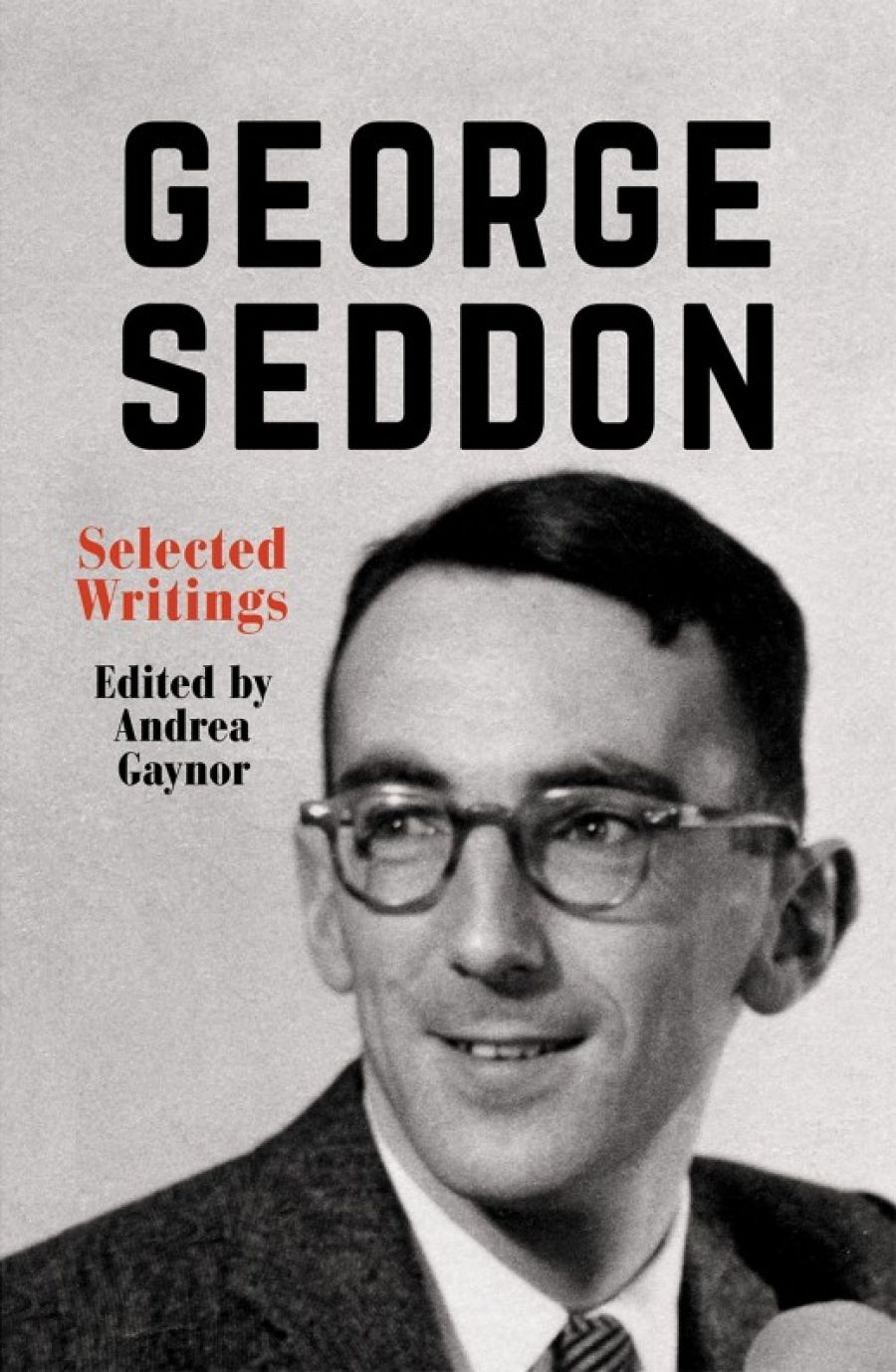
- Free Article: No
- Contents Category: Essay Collection
- Review Article: Yes
- Online Only: No
- Custom Highlight Text:
A young George Seddon smiles boyishly from the cover of his Selected Writings, a mid-twentieth-century nerd with short back and sides and horn-rimmed glasses. This collection of Seddon’s writings on landscape, place, and the environment is the third in the series on Australian thinkers published by La Trobe University Press in conjunction with Black Inc. The other two, Hugh Stretton and Donald Horne, were also on mid-century men.
- Grid Image (300px * 250px):

- Book 1 Title: George Seddon
- Book 1 Subtitle: Selected Writings
- Book 1 Biblio: La Trobe University Press, $32.99 pb, 334 pp, 9781760641627
Like Stretton and Horne, Seddon began his academic career studying for a Bachelor of Arts, in his case in English Language and Literature at the University of Melbourne. Appointed as a lecturer in English at the University of Western Australia in 1956, he was intrigued by the difference between the landscape and vegetation of the south-west corner of the continent and his native Victoria, and he enrolled part-time in an undergraduate science degree in Biological and Earth Sciences. In the mid-1960s he completed an MSc and a PhD in geology at the University of Minnesota. With deep professional training in both, Seddon convincingly straddled C.P. Snow’s two cultures of science and the humanities. In 1974 he was appointed the founding director of the Centre of Environmental Studies at the University of Melbourne, going on to become Dean of the Faculty of Architecture and Planning.
As Tom Griffiths says in his perceptive introduction, Seddon’s twin passions were landscape and language. He was a skilled bushwalker and canoeist and an enthusiastic gardener, as well as a prolific and erudite writer whose best-known books are Sense of Place (1972), on the coastal plains of Perth’s Swan River; Searching for the Snowy: An environmental history (1994); Landprints: Reflections on place and landscape (1997); and The Old Country: Australian landscapes, plants and people (2005). He also wrote many essays and some influential government reports. What makes Seddon’s writing on landscape and the environment distinctive is his capacity to understand both the physical patterns of the land and the way humans have used, transformed, and imagined it, all presented in crisp, jargon-free prose.
My favourite essay is the first, ‘The Rhetoric and Ethics of the Environmental Protest Movement’. It was written in 1972 when Australian environmentalism was shedding the polite gradualism of the conservation movement for angry direct action. Here Seddon’s deep knowledge of English literature is on full display. He names one of the environmental movement’s rhetorical modes the Jacquard, after Jacques in Shakespeare’s As You Like It, who personifies a melancholy despair. Seddon is impatient with hand-wringing, instead looking for practical, achievable solutions to urban and environmental planning and to fostering an ethic of custodianship.
The editor, Andrea Gaynor, a West Australian environmental historian, has divided Seddon’s writings into three sections: landscape and place; gardens; and reports from consultancies. Himself a gifted gardener, Seddon notes that ‘gardeners are one of the most important groups of land managers in this country, since between us we manage more than 50 percent of the all urban land in Australia’. That was written in 1997. Would it be true now as larger houses take up more land on smaller blocks?
Many of these essays were written last century. Reading them now prompts reflection on what has changed in Australia’s engagement with its urban and natural environment. Our population is much bigger, more habitat has been lost, and the climate crisis threatens a sixth mass extinction and a radically changed planet. But there is also greater popular environmental knowledge and awareness and a much better understanding of the way Indigenous Australians managed and transformed the land. Seddon has a profound grasp of our continent’s geology and of the impact of European settlers, but he has little to say about Indigenous settlement. When he was writing, this was not part of public general knowledge in the way it now is, thanks in large part to the publication in 2011 of Bill Gammage’s monumental study of Indigenous land-management techniques, The Biggest Estate on Earth, and more recently of Bruce Pascoe’s bestselling Dark Emu (2018), on Indigenous agriculture.
Tom Griffiths’s introduction does a superb job of placing Seddon’s writing and practice in its historical context. Seddon had faith in his fellow citizens, a democratic commitment to landscape and urban planning that brought enjoyment and amenity to as many people as possible, and a practical optimism about what could be achieved. While much of his writing is of mainly historical interest, his persistent and courteous practice as a teacher, writer, and consultant to government is a stellar object lesson into how to be an effective Australian public intellectual and a reminder of the importance of the humanities in grounding a sense of historically informed civic responsibility.


Comments powered by CComment